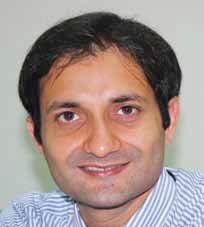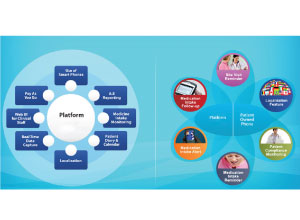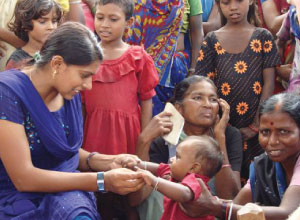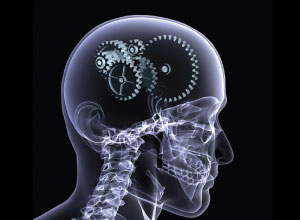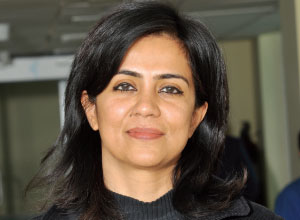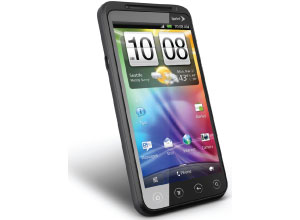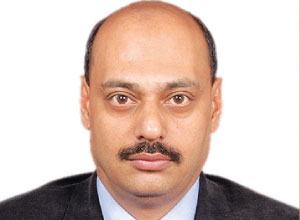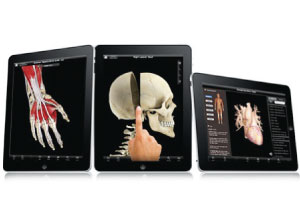
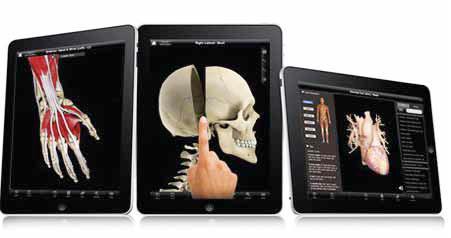 A revolution is happening in healthcare sector. It is called: Telemedicine 2.0. This new revolutionis providing many with the hope of access to quality healthcare anywhere, anytime
A revolution is happening in healthcare sector. It is called: Telemedicine 2.0. This new revolutionis providing many with the hope of access to quality healthcare anywhere, anytime
By Pragya Gupta

Handheld devices have very important role to play inhospital information management and patient care.Devices like PDAs, smartphones, tablets, hand monitors,and scanners are easily available in the market. Tabletsare the latest in the array of devices that the healthcare segmentis betting on.
Usage of tablet computers and smartphones in health segmenthas had the effect of providing us with better outcomes inpatient care. Tablets and smartphones are widely being seenas tools for expanding the reach of education. But now thehealthcare industry is taking the leverage of handheld deviceslike tablets to have an efficient health service delivery.
The Rise of the Handheld

Healthcare industry works as an enterprise, which has far toomany critical needs and features. Enterprise segment has alwaysbeen chasing after mobility. Tablets were first accepted asmobile computing devices by consumers, but gradually theirsignificance has been realised by two important sectors wherereach is still a challenge – healthcare and education.
Healthcare delivery is a function of diagnosis, care plan andtimely action. The handheld devices can help in reducing thetime that is usually wasted in transmitting information from oneinterface to another. Devices can lead to seamless integrationof information leading to a faster decision making process.However, use of new devices and technology must be combinedwith good clinical practices.
The handheld products and its applications are accepted inthe vertical because of the mobility it offers to the doctors andpatients for care and administration.
Devices improving healthcaredelivery
There are two major roles that tabletsplay in healthcare. The first is clinical rolethat is for patient care and the second isfor non-clinical role, which is mainly administrative in nature.
In the clinical process, these devicesare directly used for diagnosis and carelike the glucose checks, blood pressureequipment, ECG and ultrasound, etc. Over a period of time these devices havebecome smaller and smaller and are nowmore or less portable.
Their non-clinical use offers CEOsand managers the facility to track theperformance of the hospital. Use of tabletsand smartphones keep them connectedround the clock through closed group emails, group instructions, customerfeedback, graphs, charts, etc.
These days it has become commonfor ordinary stores and nursing countersto use the bar code scanners for quickdisbursal.
Typically hospitals where Iworked they use Bar code scanners inlab for sample collection and processingin automated equipment. There areglucometers in wards, portable USG,ECG, Blackberrys for communicationand emails for all senior managers,and few other devices, says Dr AkashS Rajpal, MD and CEO, EKOHEALTHManagement Consultants Pvt Ltd andformer AGM-Operations and IT Head, LH Hiranandani Hospital.
Healthcare providers are always hardpressed for time. The premise of a handhelddevice is to bring information in a mobilework environment at the time of need.Such a promise holds a huge benefit in a healthcare setting. This can free the providerfrom being tethered to a desk.
| Neena Pahuja CIO, Max Healthcare Pvt Ltd |
 We are actively planningto extend the reachto our various datasources on hand held devices. Towards thisend we are looking for windows based deviceswhich should be costand power efficient, andprovide new features likehandwriting and voicerecognition |
In our hospital, we have implemented mobility of access device at the pointof care by the use of Computers onWheels. Access of diagnostic images on handheld devices and patient ADTmessages are also being made available.Looking at the new age of tablets, I soon see some of the roles done onCOWs moving to these tablets. Additionally,these tablets have good softwaresfor handwriting recognition, which thedoctors really need for entering notesinto the computer,says NeenaPahuja, CIO, MaxHealthcare Pvt Ltd
There are manyother critical applicationswhere tablets and handheldsare playing crucialrole. Some of the important areaswhere handhelds are being adoptedinclude ECG (OPD/Consulting rooms,wards, ICU, casualty,and monitoring devices whileshifting patient with bed/ambulance), Blood pressure devices, USG(portablein ward/ICU), Pulse oximeters (ICU/Casualty), diabetes insulin monitors,fetal heart monitor(labour room/ward),TENS (Transcutaneous Electrical NerveStimulation(physiotherapy/ward/OPD), Tablet PCs for consultants, nurses toview patient charts/communication), inventory scanners (bar codes in lab,pharmacy and stores), Smartphones inadministrative and nursing for dose calculation,home alerts, home monitoring devices after discharge.
Market and players
A report has estimated that total handheldhealthcare device market is aboutUS$ 9 billion. Total sales in 2009 for patientmonitoring tools was about US$ 6 billion and PDAs, Smartphones, TabletPCs and handheld scanners generatedabout US$3 billion. Market is expectedto grow at a rather fast pace.
Many players have now introducedcustomised tablets for healthcare. RIM,Apple, GE Healthcare, Global Media,Medtronic, Omron, Siemens Healthcare,Socket Mobile, Welch Allyn, HP, Motorola, etc. are now offering products in variousplatforms. In fact, Blackberry andApple are leaders in tablet and smartphone market in healthcare. Androidplatform based devices are also gainingmomentum in the market as the openplatform of Android is an attraction.
|
Healthcares wish list from handhelddevices
|
With the increasing utility of these productsmore and more healthcare providersare seeing tablet as a solutions forproviding better service and internal hospital management. Still there are manyhospitals, which have not adopted thesehandheld devices due to reasons like lackof supporting infrastructure in the hospital, resistance among doctors, securityrelated issues, etc. But they are welcomingtablets with open hands and lookingforward to adopt these devices in nearfuture. Dr Karanvir Singh, (Head of HISImplementation), Sir Ganga Ram Hospital(SGRH), Delhi says, Personally, I feel that handheld devices have a big role to play inhospital information systems. However,the hospital is yet to adopt tablets.
Many hospitals have started by usinghandheld devices from one vendor,and gradually they started using devicesfrom multiple vendors. For instance, NarayananNetralaya started with iPad andnow they are using blend of iPad andBlackBerry. Similarly, Max healthcare isusing iOS, Android, and Blackberry, allof which allow the provider to access diagnostic images and results in real time,helping a faster formulation of care plan.For mobility on EHR, they are working onWindows based tablets.
|
Dr Anand Vinekar |
|
|
Dr Anand Vinekar, Associate Professor& Head, Department of PediatricRetina & Pediatric Visual Rehabilitation,Narayana Nethralaya Postgraduate Instituteof Ophthalmology, Bangalore, says With the use of these devices, I can talkto patients and ensure that I am seeingyour reports and images according to the condition we will call you for consultation.If technician gives the report, patient feelsthat the doctor has not seen report or not paid attention. We thought we need tointegrate it to cover the gap so we havestarted with Blackberry solutions.
Opportunities Galore
The adoption level at private hospitals ismore than that in government. However,government hospitals are gearing up toequip themselves with tablets and otherhandheld devices.
Tier -2, 3 and rural markets offerhuge potential for tablet and smartphonecompanies. This is a market thatneeds infrastructural revamp to integratehandheld devices in non clinical function. The increasing popularity of3G and WIMAX technologies in the ruralareas and smaller cities will reinforcethe adoption.
Hospitals that have experience in tabletsare looking for acquiring more andmore tablets. We are actively planningto extend the reach to our various datasources on hand held devices. Towards this end we are looking for windowsbased devices which should be costand power efficient, and provide new features like handwriting and voice recognition,says Neena Pahuja, CIO, Maxhealthcare
Factors for choosing handhelddevices
Security If doctors use their own tabletsthan there should be a way of making sure they can be used securely.
Mobility Mobility is the key. Whileopting for any device it should be crosschecked whether it suits your requirement.For instance, to conduct remoteconsultations with a patient faster connectivityand high resolution camera optionsin a tablet is a must.
Battery life Mobility can only be offeredif tablets have battery backup forlong hours. Invest in devices with a longbattery life and short recharge time.Available apps Different tablet runsdifferent apps, so it is really important toresearch and compare what all application are available on different platform.The tablet should be chosen that supportsall the apps that a doctor needs.
Central file system The Androidoperating system includes a centralizedfile system. The iPad lacks this, meaningfiles might not be easily movable fromone app to another.
Note-taking style Certain tabletsallow freehand sketching and longhandnote-taking, which some doctors mayprefer.
Tablet TechnologyGoes a Long Way inEstablishing EffectiveServices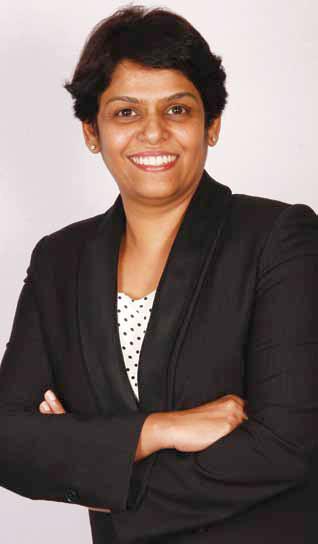
Annie Mathew Please give us an overview about tablet market in Indiaespecially in healthcare segment? Tablet devices could deliver a lot to doctors, practitioners andtelemedicine experts. In India, there is a huge need to outreachthe rural population through technology such as telemedicine.These tablets actually make a massive change in the way wedeliver services. It is going to bridge the gap between doctorsand the number of patients. This helps him track many patients and he can actually talk to the patient via video chat. Thesetechnology interventions actually go a long way in establishinghow big vendors are making it available in the right time at the right place. The devices which are out of the field canbe controlled from a central location, and thats what a Blackberry enterprise server does. So BlackBerry Enterprise Serverat the core allows this data from those devices securely and aspecific compression technique reduces the band width and battery usage This is an emerging space. It could be annoying to put it as amarket cap, because, its just an outcome. We have deployedservices at various places like Narayana Nethralaya, MaxHospitals and Nanavati Hospital in Mumbai. Our technologyplatform provides seamless support to the right and relevantpartner for developing deployed solutions. What can be the emerging areas where these Playbooksor tablets, the hand-held devices can be used? Recently, we launched the e-track on Playbook. e-track is anequipment that sets in the ICU and monitors about 12 or 14parameters of the patients in the ICU. This kind of technologymade this collaboration very much easier. Another area isurban-rural telemedicine to remove the rural part. Technologyreduces the time and thus facilitates better healthcare servicedelivery. By when do you think we can expect such servicesexpansion in India? Teleopthalmology solution in Narayana Netralaya or the e-trackwhich is the ICU monitoring has already emerged as a successand the pilot phase will be finished by March. We areworking with government and government hospitals to createa commercial and sustainable model. The early adopters as ofnow are definitely the private players. But definitely governmenthospitals are also coming up. We have seen lot interest a lotof interest from the government side also at the telemedicine congress, the Cardiology Society of India. A huge interest fromthe e-governance groups at the centre, from NRHM, they areall very interested and they are discussing this technology andthey are supporting this. The government has equally invested in this, just waiting for right model that will make it scalable andsustainable. What should be done to overcome concerns aboutprivacy and lack of infrastructure support? We need secure relations in India where the patient demandsfor privacy of his reports irrespective of the fact how minor aproblem may be. In rural setup, a doctor addresses one patientin a single room with others waiting in the same room,thus violating the privacy of the patient. When I talk enterprisegrade then we shouldnt be quiet. We can still make it workthrough a sustainable solution. |
Be a part of Elets Collaborative Initiatives. Join Us for Upcoming Events and explore business opportunities. Like us on Facebook , connect with us on LinkedIn and follow us on Twitter , Instagram.


